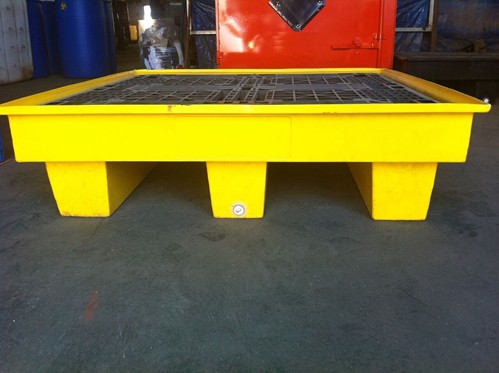Shipping pharmaceutical products comes with boosted challenges due to rigid health and hygiene needs. Pharmaceutical supply chains need to limit the risk as much as possible. Ensuring all aspects of the shipping system meet the standards needed is the solution.
According to Evaluate, shipping disasters in the pharmaceutical market can be costly. In temperature-related problems alone, Cargosense says it was estimated that the healthcare industry as a whole lost $35 billion in 2014.
The costs incurred are not just the value of the products lost but also replacement, cause analysis and unused logistics.
Choosing the right material for pharmaceutical pallets is a crucial part of risk comfort both in terms of financial loss and in protecting the buyer.
What goes into the handling and transport of pharmaceuticals?
Regulations around what companies can and can’t do when it comes to transporting and distributing different types of pharmaceuticals. Dangerous materials and any good where sterility is an important consideration vary based on region and local authority.
For domestic shipping within Australia, varying rules and compliances can make it difficult to select a material or method that upholds throughout each territory. For example, the government of South Australia has its own code of practice around the transportation and storage of drugs of dependence and how they’re transported via road, rail or air.
However, while many regulations refer specifically to the storage and protection of dangerous or vulnerable goods, what of the materials they are transported on? The Australian Pesticides and Veterinary Medicines Authority (APVMA) code of good manufacturing practice sheds some light.
Is sterility important when transporting dangerous or vulnerable goods?
Plastic pallets can be sanitised more easily and is overall a more hygienic option.
For the APVMA, sanitation and hygiene, particularly the ability to be easily cleaned is an important consideration:
- “Material must be transported between premises or buildings in a manner that ensures that the integrity and status of the material is maintained.”
- “Items brought into sterile manufacturing areas, including means of transport, should be of a standard of cleanliness compatible with the environmental standard for the area.”
- “Areas for the production of sterile products should be subjected to regular, complete cleaning and disinfection. The importance of handling microbial content of the air and surfaces should be routinely scanned.”
Transporting pharmaceuticals with wooden pallets has many drawbacks
Concerns around the suitability of wooden pallets hit the news when several big pharmaceutical companies had to recall their products due to contamination.
Following complaints from buyers of mouldy and mildew-like smells. It was discovered that a chemical fungicidal and flame retardant treatment called 2,4,6-tribromophenol (TBP), combined with excess moisture in the pallets, had resulted in the production of the chemical 2,4,6-Tribromoanisole (TBA).
The presence of the chemical on the product the buyer received caused instances of various stomach issues such as vomiting and diarrhoea. Over a 3-year period, it is estimated that the cost to the industry was in the region of $1 billion, according to Pharmaceutical Manufacturing.
The problem resulted in the FDA issuing a statement warning that wooden pallets treated with TBP should be used with precaution in any area of drug packaging or storage.
With the need for getting pharmaceutical shipments through customs in a timely manner so crucial, what do pharmaceutical companies need to consider when picking international shipping pallets?
Choosing a pallet material that can be cleaned to match the level of sanitation needed to safely transport medicines, drugs and other similar materials. It makes meeting regulation needs a much easier and less time-intensive task.
While international shipping and transportation is an activity rife with a challenge for any industry. The pharmaceutical industry’s need for precisely controlled environments along complex routes makes it uniquely demanding. With the market seeing a shift towards the pharmaceutical pallet transportation of high-value, low-volume drugs often designed for personalised use. The success of pharmaceutical shipments is of vital importance not just financially; lives can depend on it.
1. Temperature control
The specialised nature of medications, along with the increased need for cell-based regenerative therapies. It means that the demand for the so-named cold-chain utilisation has continued to increase. The potential for useless products or even deadly side effects as a result of temperature standard failures makes this challenging aspect of drug transportation particularly vital.


Research by Cargosense found that the pharmaceutical industry incurs over US$15 billion in losses due to temperature errors during shipping alone.
To make this even more challenging, traditional wood pallets used for the packing and shipment of pharmaceutical goods regularly suffer from temperature extremes. It is required for the safe movement of medication. Moisture absorption can cause warping, leading to damage to the contained. In the wake of increased demand for products to be kept at below-freezing temperatures, many pharmaceutical companies are moving towards more durable plastic pallets.
The pharmaceutical industry’s need for precisely controlled environments along complex routes make shipping uniquely demanding.
2. Regulation (To handle Shipping Pharmaceuticals)
Against a background of increased clinical trials and the movement of cells, ruling bodies have put in place tougher procedures to regulate and ensure the safe movement of pharmaceuticals. Amongst other things, these regulations aim to maintain rigid hygiene practices. Notably, the World Health Organisation defines that transportation containers are regularly cleaned.
Maintaining the required standard is both time-consuming and costly, and compliance increasingly relies on the use of the most modern materials. Plastic pallets, with their smooth and moisture-resistant surfaces, have always proved themselves to be the most hygienic option. They allow for quick turnarounds, rather than the time-costly methods required to thoroughly sterilise wood.
3. Warehouse management
The last ten years have seen the pharmaceutical industry double in size. This increase in sales and stock has made the correct management and efficiency of available warehouse space more important than ever. Streamlining logistics and supply chain efforts to ensure maximum utilisation of storage space. If it is combined with the strictly controlled conditions required for storing medication, it is a consistent challenge. Acquiring hygienic pallets that allow stackability and safe handling can drastically reduce warehouse management issues.


Eco Pallets team provide a variety of durable, easily cleanable and storage-friendly bulk containers and pallets to fit the needs of the pharmaceutical industry. Contact the Eco Pallets team for more information.









Comments are closed.